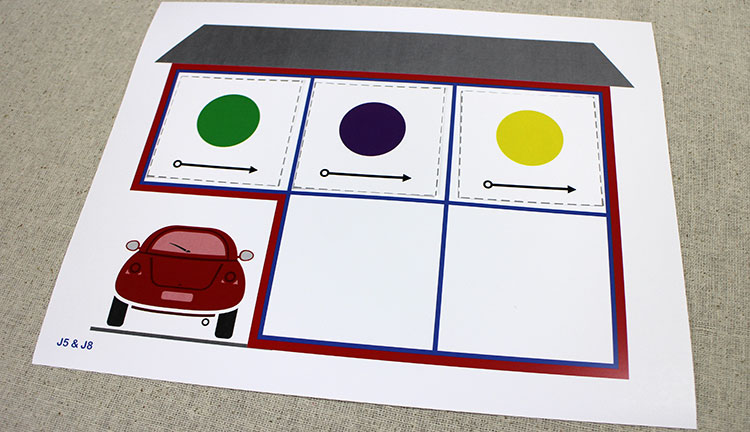J5: Snip It Off: First Sound
1. Overview
“Snip” a sound off the beginning of a word to make a completely new word. Your child will take a three-sound word, and remove a sound from the beginning to create a word with two sounds (phonemes). This is the reverse of the previous activity, Snap It On: First Sound. NOTE: This activity is about counting and ordering the sounds in words. It is not about spelling!
J5: Snip It Off: First Sound
2. Materials
Print out the word list, mat and sound counting cards, preferably on sturdy card-stock paper. Cut apart the sound counting cards. The word list is for the adult’s reference only. Set the mat in front of the child, with the sound counting cards next to it. ↑ Top3. Activity
Video: How to play Snip It Off: First Sound
Explain to your child how you can have one word and then take a sound away from the beginning of it, “snipping it off,” to make a brand new word with the parts that are left. Review dividing words into individual sounds, and emphasize counting the sounds.
Adult: Sometimes you can snip a sound off the beginning of a word to make a brand new word. Let me show you how. Listen to my word: rake. “I will rake the leaves.” Rake. What word? Child: Rake! Adult: What’s the first sound you hear in rake? Listen: rrr-āāā*-k. Child: rrr. Adult: Yes. Put a card for the rrr sound here. [point to top left “window” on mat] Child: [Puts down sound counting card.]Continue this way until the child has identified the second and third sounds in rake and has put a sound counting card in the top row of the mat for each sound.
Adult: Now point to each card in the top row and say its sound, in order. Always start here. [Point to top left “window.”] Get ready. Child: rrr [points to first card] āāā [points to second card] k [points to third card] Adult: Now I’m going to snip off a part of rake. You find the sounds I say and move those cards from the top row to the bottom row. Get ready: ache. “I have a tummy ache.” What word? Child: Ache. Adult: What’s the first sound you hear in ache? Child: āāā. Adult: Yes. Find the card you used for the āāā sound in rake and move it down to the bottom window here. [Point to bottom left “window.”]Continue this technique of identifying the sound and moving the sound counting card for the /k/ in ache.
Adult: Touch under the cards in the bottom row and say the sound for each card. Child: [points to left card] āāā [points to right card] k. Adult: Say the sounds fast. What word? Child: Ache! Adult: Look at the top row of windows. Tell me what sound you snipped off of rake to make ache? Child: rrr! Adult: Yes. You snipped off the rrr sound at the beginning of rake, and the sounds that were left made the word ache.Have the child remove the sound counting cards from the mat to get ready for the next round of the game. “Snip” sounds off of six to ten words in a session.
NOTE: A line above a vowel (for example, ā) indicates that it is the “long” vowel sound, which is the same as the vowel’s name.
↑ Top4. Confidence Builder
- Use only words with continuant consonant sounds (e.g., sail, name, zone).
- Reduce the number of words per session, and repeat them several times to insure the child understands the activity.
5. Variation
At the end of a round, encourage the child to “snap” the bottom row sounds back to the top row and say the original three-sound word. ↑ Top6. Small Groups (2-5 children)
Lesson Objective: Using manipulatives and a counting mat for visual aids, children will hear a three-phoneme word, say and count the phonemes in the correct order, and delete the initial phoneme to create a new two-sound word. GELDS (Georgia Early Learning & Development Standards): CLL6.4f Georgia Standards of Excellence: ELAGSEKRF2.e Common Core State Standards: CCSS.ELA-LITERACY.RF.K.2.E Additional Materials:- enough work mats and sound counting cards for each child
- optional: pocket chart
Leave a Reply
